Colouring in pages for kids: do you love them or hate them? Do they stifle creativity or encourage it? Here’s what I thought and why I changed my mind.
What’s wrong with colouring in pages?
Colouring in pages are too prescriptive: they stifle creativity and don’t encourage children to express themselves and their own ideas. They’re cookie-cutter projects, expecting the same results all the time with little room for self-expression.
That’s what I thought. I never bought colouring in books for my children and I’d always provide blank sheets of paper for free drawing instead.
And then along came my youngest daughter, and she somehow came across colouring in sheets and fell in love with them. And through her I realised I was wrong. My outlook for learning is to go with the child, and help them explore their interests, and use what they love to introduce new skills and areas of learning. So, we tried it, and I changed my mind. Turns out colouring in pages can encourage creativity of all kinds: in art, language, and play.
Here’s what my daughter taught me:
:: you can use colouring in sheets to tell stories and develop language skills: playing I spy with the pages, talking about what’s happening in the picture, and narrating all sorts of stories as you colour in
:: colouring in pages featuring film and TV characters can be just the invitation a child needs to pick up a pencil and being to work on fine motor skills
:: colouring in page characters can be cut out and turned into puppets for lots of imaginative play
:: colouring in pages can let you explore emotions, as you notice the characters’ expressions and talk about how they are feeling, and why, and how you sometimes feel like that too
:: an introduction to mark making and art through colouring in pages can help a child discover paints, pencils, oil pastels, pens, chalk…..broadening the range of art materials they are experienced with
:: a perfectionist child, or one who thinks they can’t draw, can take little steps towards discovering their own talents by starting out with colouring in sheets, catching the love of drawing, adding their own doodles to the sheets, and then discovering a passion for sketching that spills over onto plain pieces of paper, which they now feel free to fill with their own art
:: colouring in pages can be relaxing and soothing, perfect for transitions such as coming home from school, winding down before bed, or when you’re on a long car journey
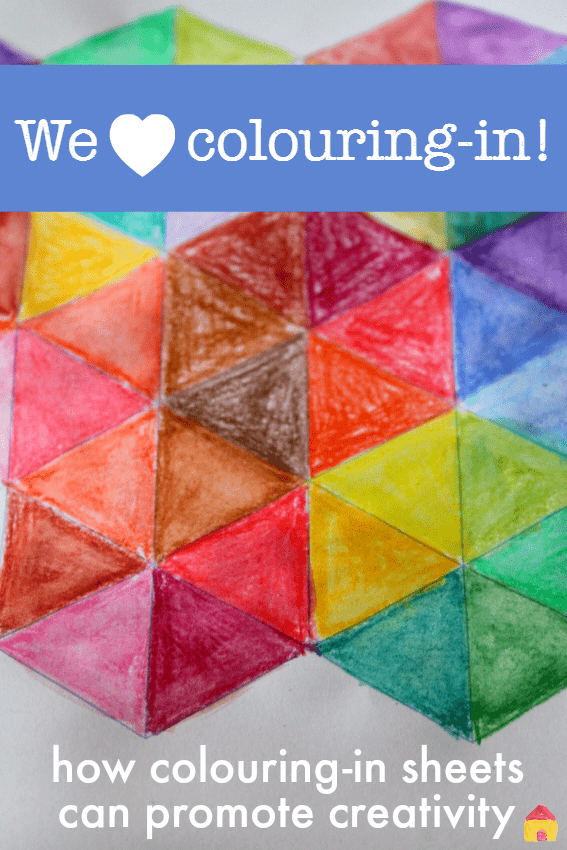
But to do this, I think it’s important to make sure there are always blank pieces of paper (and rolls of paper, chalk boards, pieces of card, canvas boards…) available alongside the colouring in sheets for children to pick up.
And I also think it’s important to mix up the materials that you set out with your sheets. Try marker pens, pencils, water colour pencils, paints, oil pastels, fine markers, chalks…
It’s good to follow your child’s interest, but important to guide and mentor them too. Help them learn about all the possibilities out there, and encourage them to try new things, little by little, as they are ready.
I know that colouring in pages, templates, and crafts are banned in some schools and early years settings, but I wonder if that’s the right thing to do. My daughter taught me to keep an open mind, to follow the child, and to encourage children into art and creativity on their terms, not only on mine.
What do you think is wrong with colouring in pages?
Do your children like colouring in? Do you think they encourage creativity or stifle it? Join the conversation in the comments.
Nurture art with the Art Spark resources!
My Art Spark resources will give you everything you need to start a joyful art practice with your children. There are two new ebooks and an online art course for your family or class. Use them and you’ll be bursting with enthusiasm and ideas that will help you make art happen. Click here to see more.


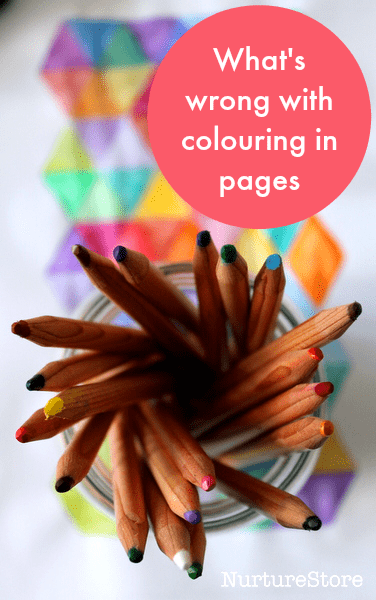
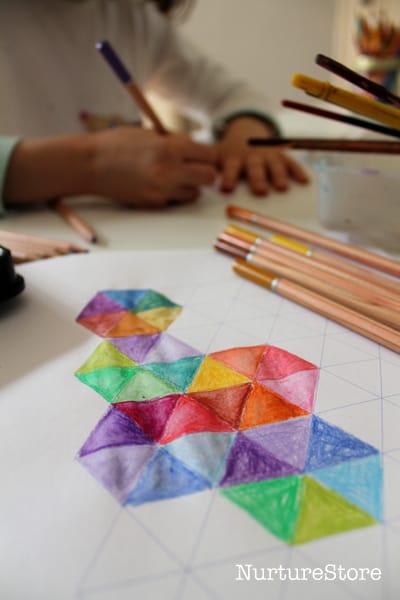

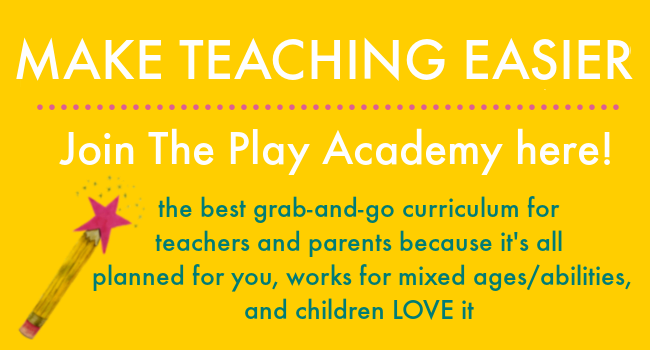
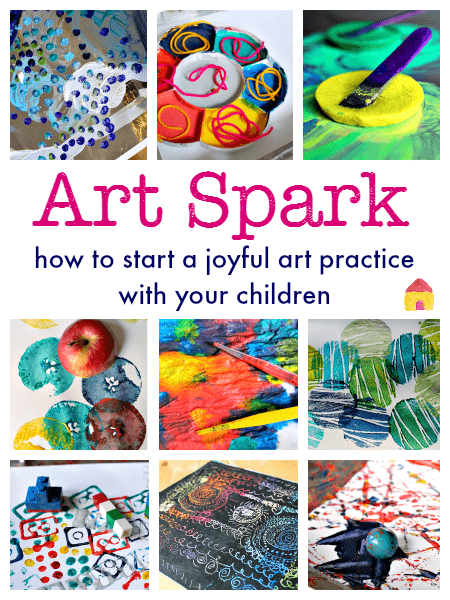
I’m still a bit up in the air about colouring in! When I was doing my studying all the tutors hated colouring in pages and would go on and on about how bad they were and I kind of adopted that position.
I still don’t like lots of commercial colouring in books – but I can see the place for some colouring in placed alongside the other drawing materials.
I remember loving colouring in as a child, and should I deny that meditative joy to the children in my class?
Thanks for this post, it has made me think a bit more about how to use colouring pages in a positive way.
Interesting article! I don’t mind colouring in pages since I used to love them as a child. But my first son does not like them. The only colouring he is interested in is having a blank paper and pen, then he makes a few circles and explains me what he did – he will be 4 in two months. No interest in art at all. Any idea how could I encourage him to at least try something new?
I must admit to loosing it more than once when ALL that was coming home in the bag from school were colouring pages, right up to second class (age 8)!!! smacked of a complete absence of creativity in the classroom.
Love this post. The great colouring page debate often creeps up on childminding Facebook group with childminders either fallen into the love or hate them category.
We do a happy mix of both and I usually have both on offer. I agree with all the positives you’ve listed of colouring pages. As long as they’re not the only thing offered I don’t see the harm 🙂
Quite frankly I think everyone overthinks things. Blank or not, let them color.
THANK YOU! I have to agree after keeping coloring pages from all six of my kids for all of the same reasons, the children came upon them at grandmas house and couldn’t believe I had kept them from them all these years. As much as I hate to admit this, there is a place in some children’s lives for coloring books. My own mother found them to be a source of relaxation to just be able to color and shade with out the stress of sketching or drawing which was something that she felt was completely beyond her abilities.
Completely agree – I’m nearly 60 and love to colour while my mind wanders , thinks , creates and solves
I am all for colouring sheets! I was a very creative child, and my love of colouring sheets/books did not hinder me from later going on to a BFA. I happily let my daughter colour on both blank sheets and pre-printed images – she loves both and uses them in very different ways.
And really, in the end Jenny above says is right – why are we overthinking this?! Let them colour!
I remember going on a creativity course where the trainer was very much against colouring in pages. All I remember thinking at the time is that it is the quality of them that matters. There are appallingly awful pictures that so many people print off and shove out for kids to do versus beautiful books like Usborne’s or The Super Book for Superheroes. Their images are appealing and only half completed so it’s the best of both worlds. We often spend time working on one page with my two eldest sons adding their own ideas to the half drawn bits whilst I get to just colour in and have some free mental space time. Stencils are far worse for limiting creativity!
See, as an artist myself I love drawing and nothing is more exciting than a blank sketch book paper. So full of possibilities and potential! But then sometimes that blank page just stares us in the face, and we don’t know what to draw. Sometimes we just don’t want to go through making our own pictures. That’s when coloring books are a life saver! Our favorite coloring books are the geometric kelidescope and mosaic style ones. They can be intense and/or meditative and are good for just being silly with color and experimenting. Especially when kids are having issues with the whole “I can’t draw perfect! But I want to draw/color something!”
Agree totally to much over thinking let children colour.
I have taught prep (first year at school in Aus.) for 18 years and have offered colouring in pages at our writing table every year. The children are always drawn to them as they offer a sense of achievement and a talking point at the table. Colouring in is very calming and quite therapeutic, even for adults. My children are also offered plain white and coloured paper of different shapes and sizes with lots of drawing and writing tools to choose from. My own children have loved them over the years too. I am very fussy and only buy books made from best quality paper and clear, easy to colour shapes in relevant and attractive pictures. I love colouring!!!
Horay! I truly believe there’s room for spontaneous creativity and a time where children need some guidance.
Colouring in sheets especially of the child’s own interest can motivate those who do not always access mark making activities. As adults we understand how easy it is to avoid those things we find too difficult. Children are the same, there is indeed room for the prescriptive and the spontaneous x
I run an in home daycare, during inspections we do not get points in art etc for coloring in pages, does not even count toward displaying children’s work. My view is that’s wrong. Yes we need the plain paper but coloring pages help children learn to follow lines, respect borders and still offers creativity. They can color a cat whatever color they want, however they want. As with their blank page art, they tell us a story about their work. There is a need and purpose for both in a child’s life.
Colouring pages are excellent for developing hand and finger control and strength for pre writing. They also teach how to follow a line (in staying in the lines) for later shape drawing and letter writing. I was very much in the anti camp based on creativity before my daughter went to preschool and I saw the benefits!
I am not going to honour colouring in pages until our children become adults and then they can decide. I know that children are competent and capable of creative representation and that I respect them enough to only offer a blank slate: open-ended art materials.
I agree that colouring pages should only be a part of the offerings available to children for creativity and mark making, and that blank paper should be the mainstay (with a variety of tools available for making marks). I think that there is a place though for colouring in, for all the reasons you have said. Storytelling, language, interactions, relaxation, motivation – all of these things can be incorporated. I think for me at the moment, it’s inspiration that is the most important reason. I have found myself that adult colouring books are inspiring my drawing and giving me ideas of what and how to draw, and liberating me from my preconceived perfectionist limitations that I have placed on myself all my life. I think if we guide children to use colouring in this way, then it can be a positive thing. We show young artists examples from the masters as inspiration; why not do the same with colouring pages? If we, or they, become lazy and colouring in is all they are ever given or want to do, then it’s a problem. But like all things in life, moderation people!
Just let them colour. Goodness why are we over analysing everything? As long as it’s a part of varied activity then what’s the harm!?
I think that if you are a good early years practitioner you can use colouring sheets. If you have to encourage some to use writing tools you can use a character they are fond of to start them with writing materials thus encouraging all the skills they need for writing. We use Anti Colouring books too which you have to add to the picture. As an example it will show a crowd with certain expressions on their faces and say ‘ Draw what the crowd can see’ I love colouring myself and mine turn out very different as an artist I use various shapes etc to fill in different parts of the picture as I find I can’t just colour but automatically colour each piece in a different way. I admit to some of my pupils loving using the colour by numbers pictures which helps them to learn colours and numbers at an early age. I find that if my pupils have chose to colour they then tend to use blank canvas afterwards. We use our colourings to cut out and make stories , too.
I do not like where teachers give same worksheets to all the children and wants them to colour it .no choice is given.here the creativity is lost .other day teacher plans some art work and all the children doing same art work and in the same manner.Again all the work looks same.
I use colouring in pages in my reception class. They have definitely encouraged boys to access the writing area and pick up pens, pencils etc. I have also seen the progress in fine motor precision as colouring in particularly with coloured pencils strengthens their finger muscles and produces much improved letter formation. They also encourage children to persevere with a task as they stay on task until all images are complete. I wouldn’t be without them in my class and nor would the children, they love them and they choose the images they want, robots, mermaids, dinosaurs etc. Colouring in sheets are essential for early writing skills!
People should stop comparing adult coloring to children’s coloring. Adult coloring is a stress reliever for adults. And for the mature colorist it can be extremely creative and skilled. Coloring for children is not extremely harmful but it’s not educational. It’s OK to pass the time, the kids like it of course, but it’s like eating junk food. Children’s brain cells are growing and they need to learn. Coloring books kill creativity. The kids become less creative and more afraid of trying it they get older so why put this insecurity them at an early age
I just want to say a huge thank you for writing this. I’m a SAHM of 2. Just a parent, not a child educator or anything like that. I kept reading about colouring in stifling creativity and how bad they were etc etc and got all on my high horse never allowing my kids to have colouring in sheets. My eldest who is almost 5, has never taken a huge interest in drawing when I put out sheets of blank paper and materials. And when relatives or friends ever gave us colouring sheets, she almost had like anxiety because she didn’t know what colour things were supposed to be. And in fact, she has been seriously struggling with life in general since her sister came along when she was 18 months. Aggressive, hating me pretty much all the time, not enjoying play, getting angry when I was being silly or trying to play etc. Well, a week ago she found a Readiness for Preschool workbook that I’d hidden in a cupboard, because somebody sent it to us and I also disagreed with workbooks. When she found it, she immediately took it to the table and started colouring in and doing all the activities. The book even went so far as telling you what colour to colour things, and she LOVED it. So, after much grappling with my own judgements around it, I sat down with her a few days ago and for 2 whole days we just sat and coloured and did the worksheets and she has been like a completely different child. Happy, smiling, playing, joking around, being silly, HUGGING ME!!!, she even told me she loved me, this is huuuuuuuge for her. And not only that, but as we did the colouring, she found confidence. It turned into her drawing extra bits, then trying some drawing on blank paper, then cutting bunny rabbits and trees and bushes out of coloured paper and making her own pictures, and the list just goes on. Given the massive changes in her, I wanted to explore just what is really wrong with colouring, am I making the wrong choice by printing her out even more colouring sheets and worksheets? Well, I think like you, I am now a convert, and your post has helped me to feel confident and more at ease about it. So thank you, from the bottom of my heart.
Kelly, thanks so much for sharing your experience. I’m so glad to hear your daughter is happy and creative. It reminds me again that we need to focus on our individual children and nurture them how they are, where they are. Best wishes to both of you – keep connecting and exploring together!
Great to see another perspective on this sometimes “contronversial topic”. The whole belief around colouring in pages and stifling creativity came from a very flawed study which had what looked like a lot of bias to prove a predetermined belief. This study was done somewhere around 1947. If there are any fresh studies always happy to have a read!
I think there needs to a balance of opportunities for children to explore their creative side. For some children colouring books give them the courage to try something creative. Anything that gives children the opportunity to develop fine motor skills, practice mark making etc. cant do them any harm. I grew up on colouring books and certainly consider myself a creative person!! There’s a whole industy around colouring books for mindfulness. Thanks for the post!!